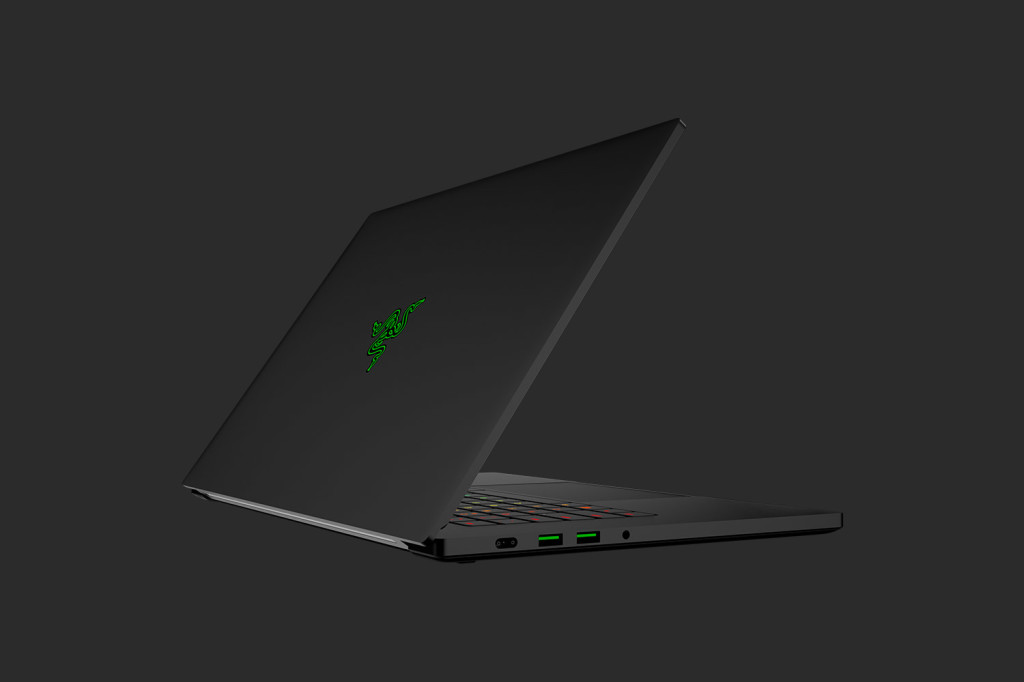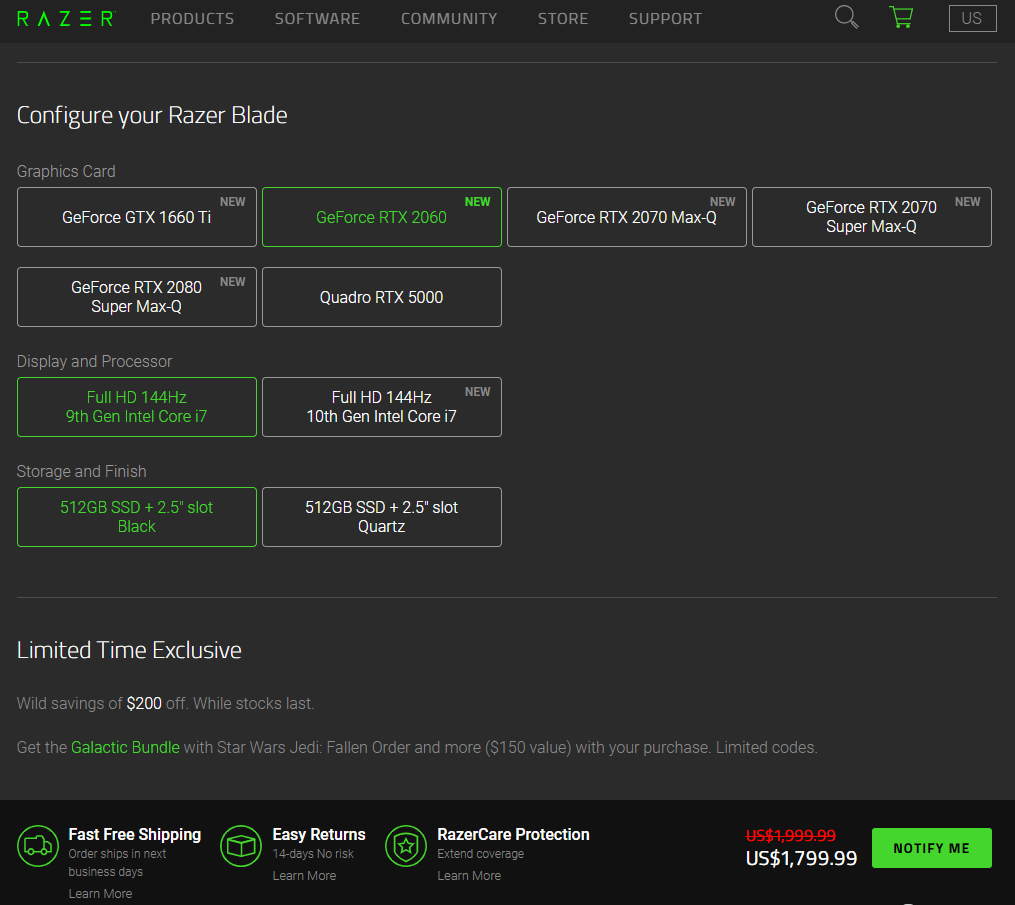Sometimes an online configuration and spec sheet is worth 1000 words. And yeah, if you want to see why some users in the pro market are switching OSes – this sums it up.
Look here, for instance. (It’s easiest for price comparison to set to the US market even if you don’t live in the USA. Well, and China uses US dollars as a de facto standard for electronics pricing, so…)
https://www.razer.com/gaming-laptops/razer-blade/shop
Look, Apple heard users saying they wanted more “pro” options but assumed that meant “high-end” – as in spending more money. We as individual artists may have actually just meant more power at lower costs. The Mac Pro and iMac Pro definitely appeal to someone, but that someone is not a cash-starved artist.
I stand by my recommendations yesterday on the Mac platform, which was a literal Apple-to-Apple comparison. But part of why I didn’t suggest that PC offerings were comparable is, well, Apple’s choices aren’t comparable to what you get on the PC.
So yeah, for the price of an entry-level, 13″ machine with no internal storage, a low-end CPU, 8 GB RAM, and no dedicated GPU, Razer (just for one example) gives you…
… a 15″ machine with a high-end (almost current-generation) i7 CPU, a hybrid SSD/HDD drive (128G + 1TB), 16GB RAM, a solid mid-range GPU from NVIDIA (which isn’t even available from Apple), and far more ports (including dedicated HDMI).
That’s a more usable primary display for pro work, a GPU that runs Adobe Creative Suite and 3D software, and yeah, more connectivity without buying a dock. They’ve even brought back the Ethernet port, though I was fine using a dongle for that. I actually wouldn’t mind if eventually some of the USB3 ports here got replaced with more Thunderbolt-capable ports, but… for now, there’s still not a lot of hardware actually needing the bandwidth of the Thunderbolt 3 side.

I’m using the 2018 version of a Razer, and I love it. Mind you, it’s not perfect – as all hardware usually involves compromise. In order to satisfy the greater power draw, these boxes use a proprietary connector, not USB-C, for the PSU – so you better remember to pack your adapter. On the 2018 version, there’s still some electrical interference noise on onboard audio output, for example; I really hope Razer and other OEMs sort out these sorts of issues. And if Razer really wants to appeal to pros, they’ll come talk to people like me – and you, the sorts of people who read this site – about creating an alternative ‘pro’ profile that turns off extra system processes. No, I don’t want some 32-bit process sitting in the background waiting to “optimize” a game or anything else.
Windows does have advantages. With some minor configuration changes, you can get it in order. MIDI and audio now work perfectly reliably – so forget what experience you may have had 10 or 15 years ago with the Windows platform. And then once it’s running, you can easily run 32-bit software and legacy tools, even as Apple turns its back on them. Installers run without tons of additional OS-level verification. It’s not as though the OS is insecure – Microsoft still aggressively patches issues. It’s more like the OS stops viewing your creative tools as security liability. Heck, software like FL Studio will seamlessly find all your plug-ins in various folders and run 32-bit and 64-bit plugs and VST2 and VST3 side by side, without complaining.
There’s another twist. My 2018 model was exceptionally easy to boot to Ubuntu Studio without even touching anything. So Windows isn’t necessarily the mission-critical OS you’ll run. In my case, I can blaze through FL Studio on Windows (which is rock solid), then boot to Linux for VCV Rack and Bitwig Studio (and SuperCollider, and Pd, and custom code).
On the graphics side, Adobe Creative Suite is blazingly fast – and on the Mac, it’s a total dog even on a machine costing twice as much. Touch Designer is hugely powerful on Windows. But I also have Unreal Engine, Notch, DaVinci Resolve, and the like – running on Linux or Windows.
It’s very possible you would even leave that set to Linux and never boot Windows. And once you’re doing that, Apple is at a notable disadvantage – because aside from configuring Linux tends to be harder on their machines, when you erase the OS as a differentiator, they just look expensive, a status symbol from some other decade.

Razer is of course pushing a lot of marketing behind their brand. But I will say, the nice thing about Razer specifically is, you get a form factor that’s more like what you’d expect from Apple. It’s not ugly and awkward like a lot of high-end commodity PCs with big specs. There’s even a 13″ model if you want something lighter. The display is nice (and matte, on mine!), and the thing feels like what you liked about an Apple machine, down to the comfortable keyboard. Of course, it’s what you liked about Apple around 2013 – before new-fangled keyboards that didn’t work. There’s no Touch Bar; the most gimmicky thing is the RGB options on the keyboard, but frankly the customization is nice enough. (It’s even integrated with FL Studio, and my current browser of choice, Vivaldi.)
You should also consider custom OEM builders, some of whom do cater to the audio market and support. Those differ by region – the USA has PCAudioLabs, with machines pre-configured (and supported) for audio uses, also with formidable specs. If it’s Linux you want, you can also look at options like System76, which support Linux as the pre-installed platform (though not necessarily audio/visual applications per se – let’s see if anyone goes after that market).
Razer has the advantage of getting a slightly fancier form factor, which some of these smaller OEMs can’t manage. And Razer’s pricing is aggressive now – able to compete with dull notebooks from the likes of Dell. Plus there are a lot of options in Razer’s configuration – less than what you might get from some Build-to-Order vendors, but still enough that let you make personal decisions about display, resolution, and specs. Did I mention that there’s a free hard drive slot that you can upgrade?
You aren’t likely to be able to get either the latest Razer or Apple in-hand – Razer’s site is set to “notify me” on the new models, because China was dealing with COVID-19 disruptions back in January while we were still pretending it wasn’t going to be “about us.” (I’ve been in constant contact with people inside China since then and … actually, should have listened more closely to what they were describing earlier.)
There is a sweet spot with Razer just as with Apple. Even as we delve into doing advanced 3D stuff as artists, we don’t necessarily need the latest-and-greatest GPU. So for instance, set the Razer Blade 15 to RTX 2060 (still a very capable GPU), and a 9th-gen i7 (again, you don’t need Intel’s absolute latest), and you still get all these specs and a 512G SSD for … US$1799. You still have a free 2.5″ hard drive slot. I’ve opened up this machine, and a hard drive installation is stupidly simple, so you could put a lot of internal storage in there and never have to worry about bringing an external drive.
Obviously, similar advice would apply to other PC vendors, many of whom are using similar innards (even if Razer has a nicer-looking external package). But then, the actual specs of an Apple that you care about – CPU and GPU – are from the end-user perspective also basically the same as what the PC offers. (Strokes chin.)
That’s more than enough to make someone switch OSes. I know it was enough for me. Apple’s lucky they have that hardware trade-in program, because you almost need the trade-in just to double spending another $1000 on their platform.
This is also why I wouldn’t rush to recommend Microsoft’s approach with the Surface Book line, which seems to ape Apple by prioritizing mobile features for the mass market over high-end specs for the pro and gaming market.
But whether it’s a gaming maker like Razer or a custom OEM, you should notice that what has happened is, what we once called “pro” is now really a new overlap between the high-end gaming, real-time graphics, and serious musician market.
More on this soon, but this moment has also made it clear – we as musicians aren’t just running a DAW. We’re making live visuals. We’re playing games to blow off steam. We’re making games. We’re making performances that run in game engines. We’re running machine learning and AI tools, and other experimental code tied to NVIDIA. And yes, we’re using more than 256G of storage – sheesh – and don’t always want to plug in a mess of external gear.
And yeah, we need to run video editing software. Apple’s got a good thing going with their Final Cut and Motion integration, and for some people, that’ll be enough. See my Apple story, and knock yourselves out.
But if it’s not enough, rather than struggle to run this software on a Mac, yeah, you can get a PC.
It’s not that Apple isn’t a choice for “pros,” but it isn’t the best choice for certain use cases. Normally the point when people start talking about buying a graphics card chassis, it’s time for an actual intervention.
The weird thing is, by unexpectedly giving a shock in the arm to the traditional computer market, this pandemic may ensure that it’s the desktop vision that defines the 2020s, rather than the anemic mobile vision that was the on-again, off-again competitor of the first part of this century.
And I think when we are allowed out of our houses again, it may be that we want to get away from computation devices entirely, and just look at each other’s faces again. But that means we may be back to the thing on your desk as the more powerful, more long-lasting investment, and not disposable computing stuff you have on you at all times.
See, and all of this sort of thinking can just start by looking at an online notebook configuration page. (That was probably more than 1000 words, and I won’t hazard any guess about what it’s worth or not.)